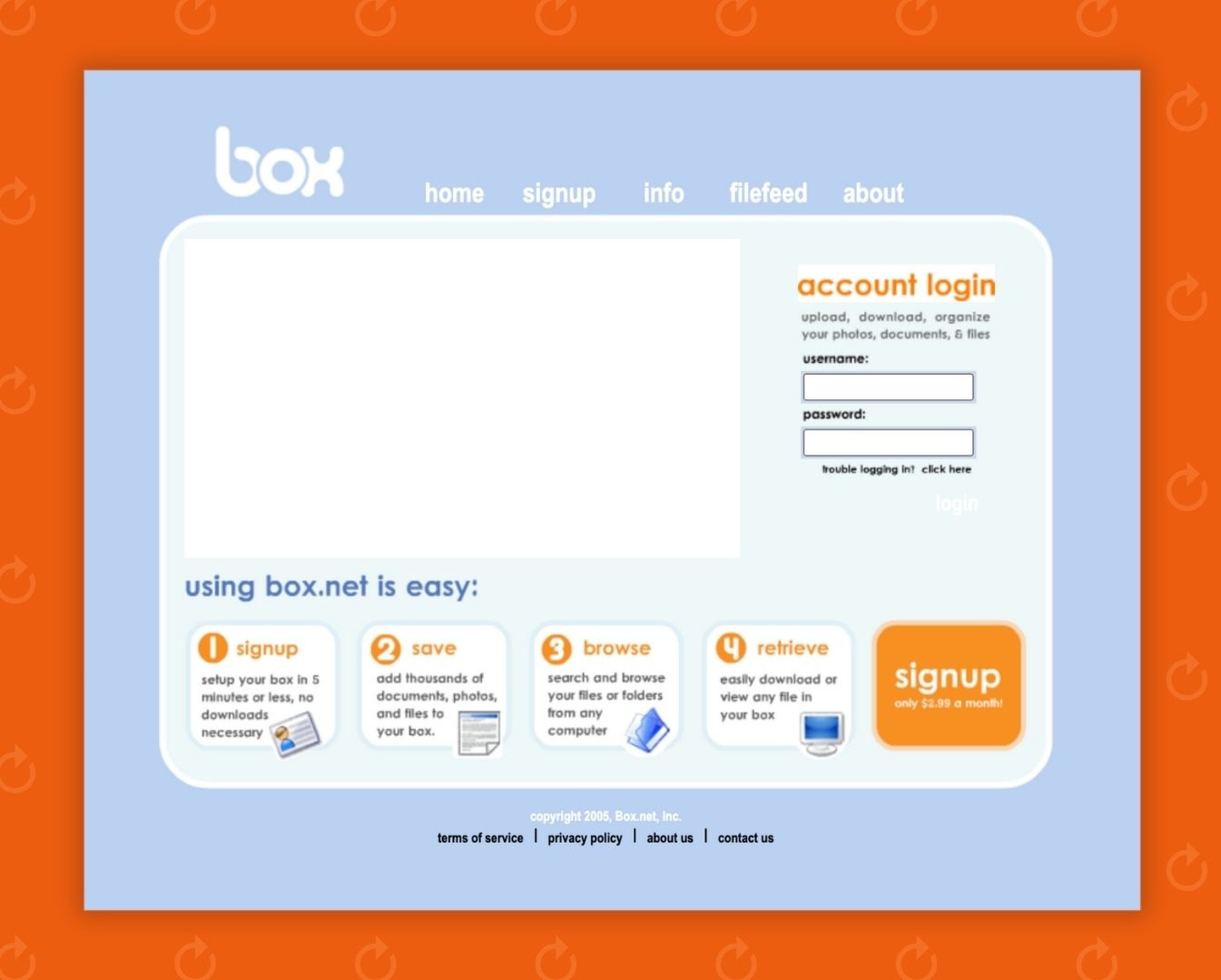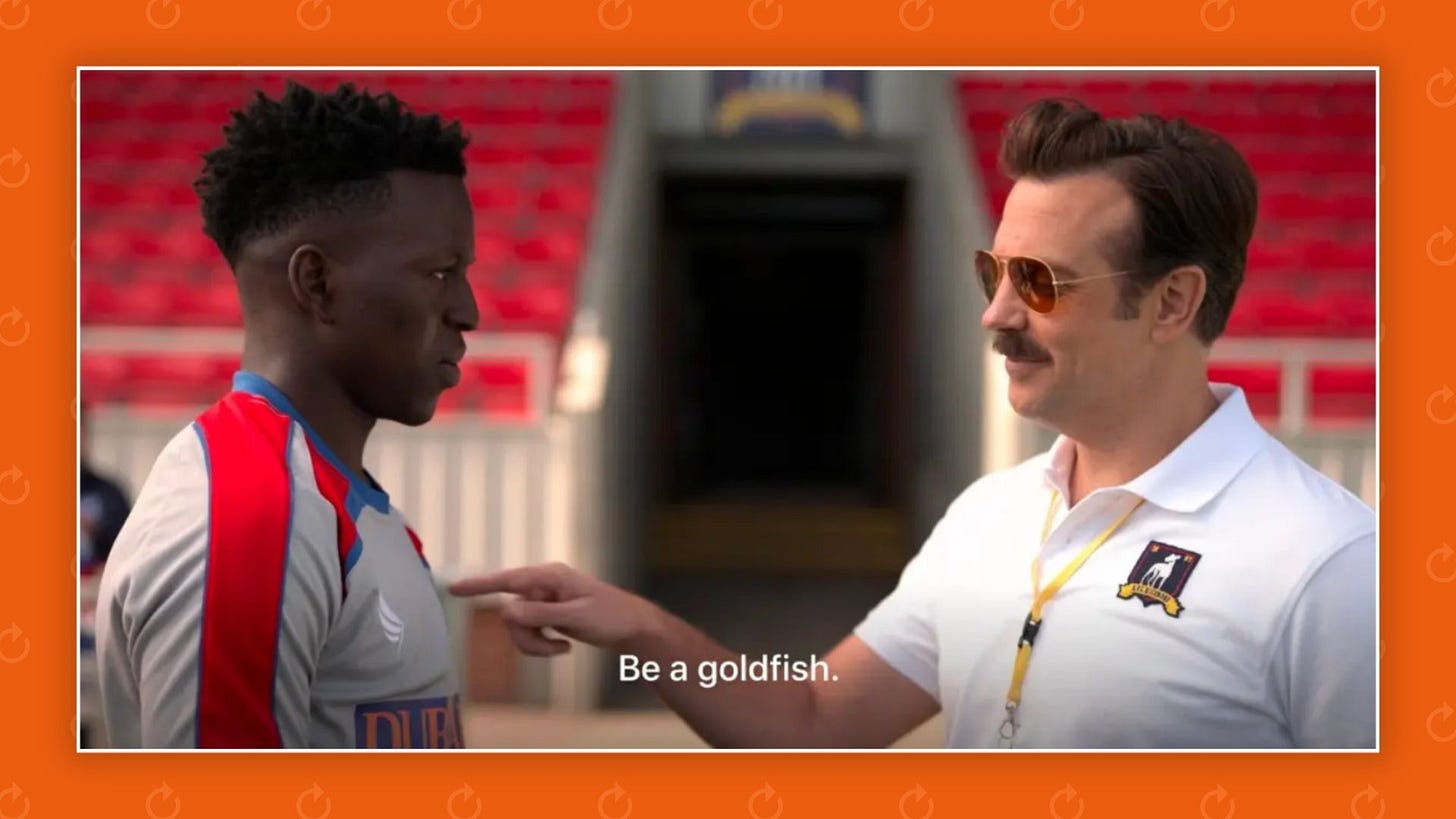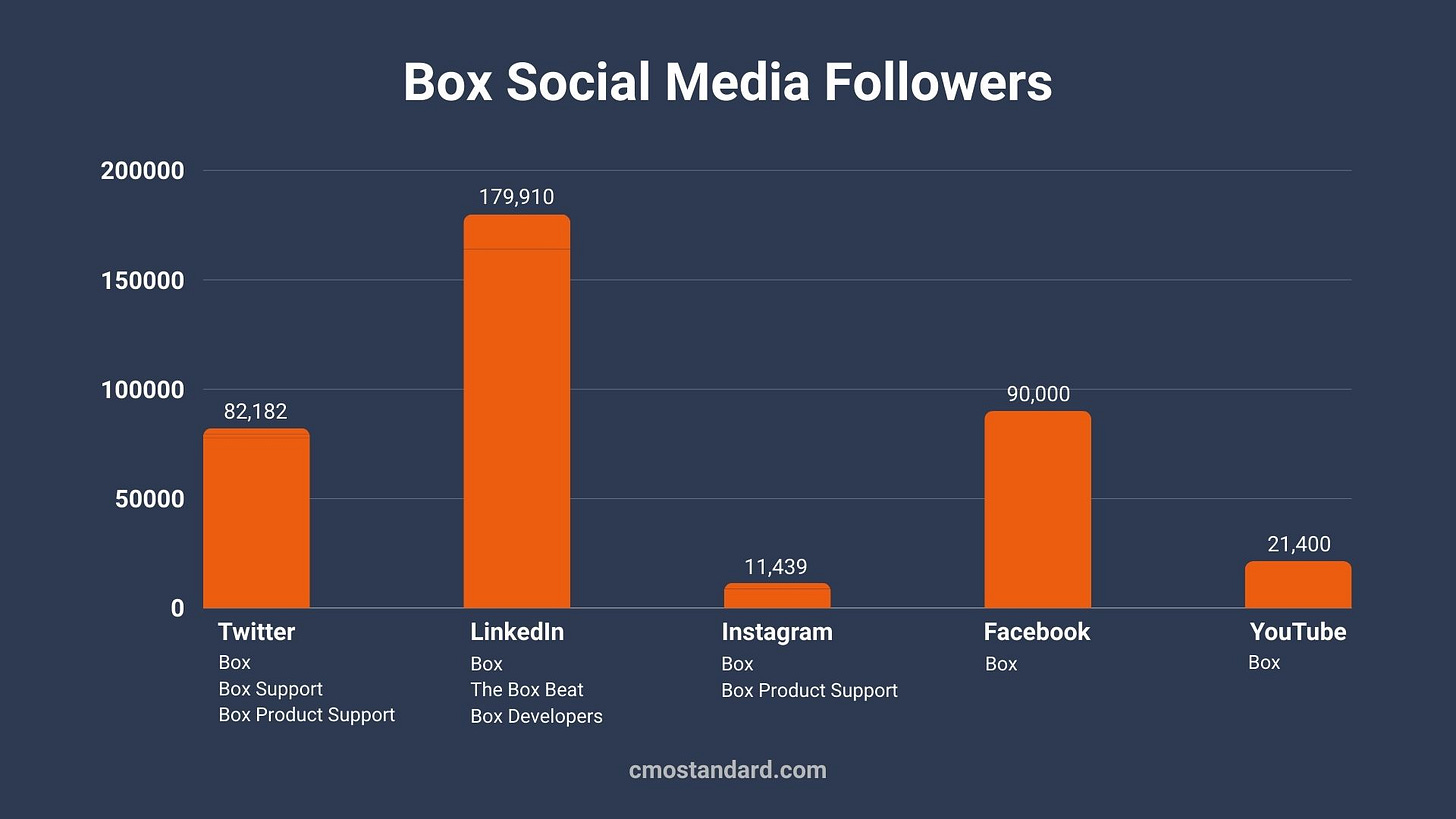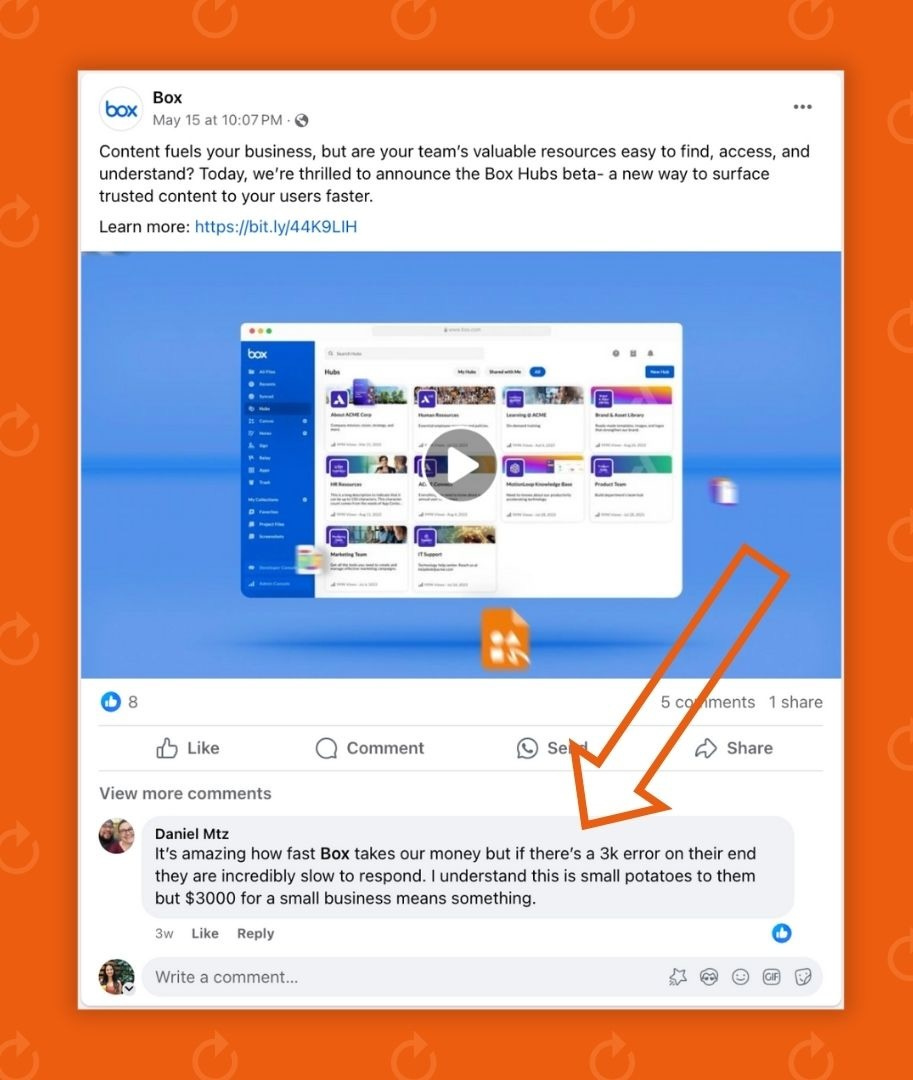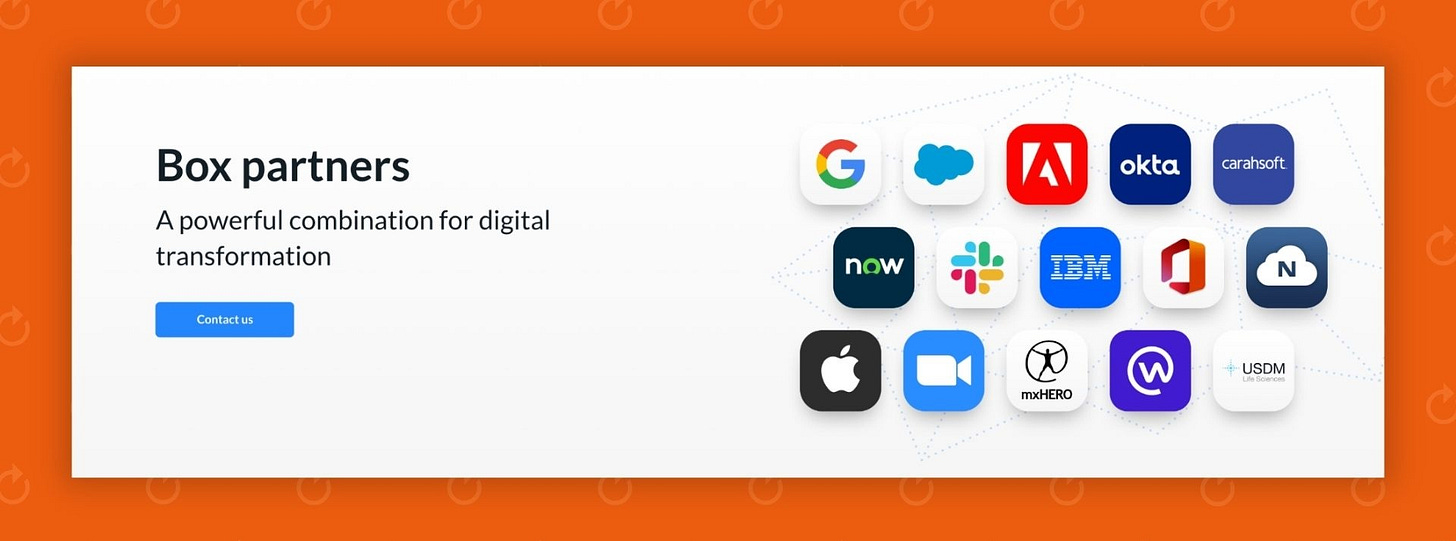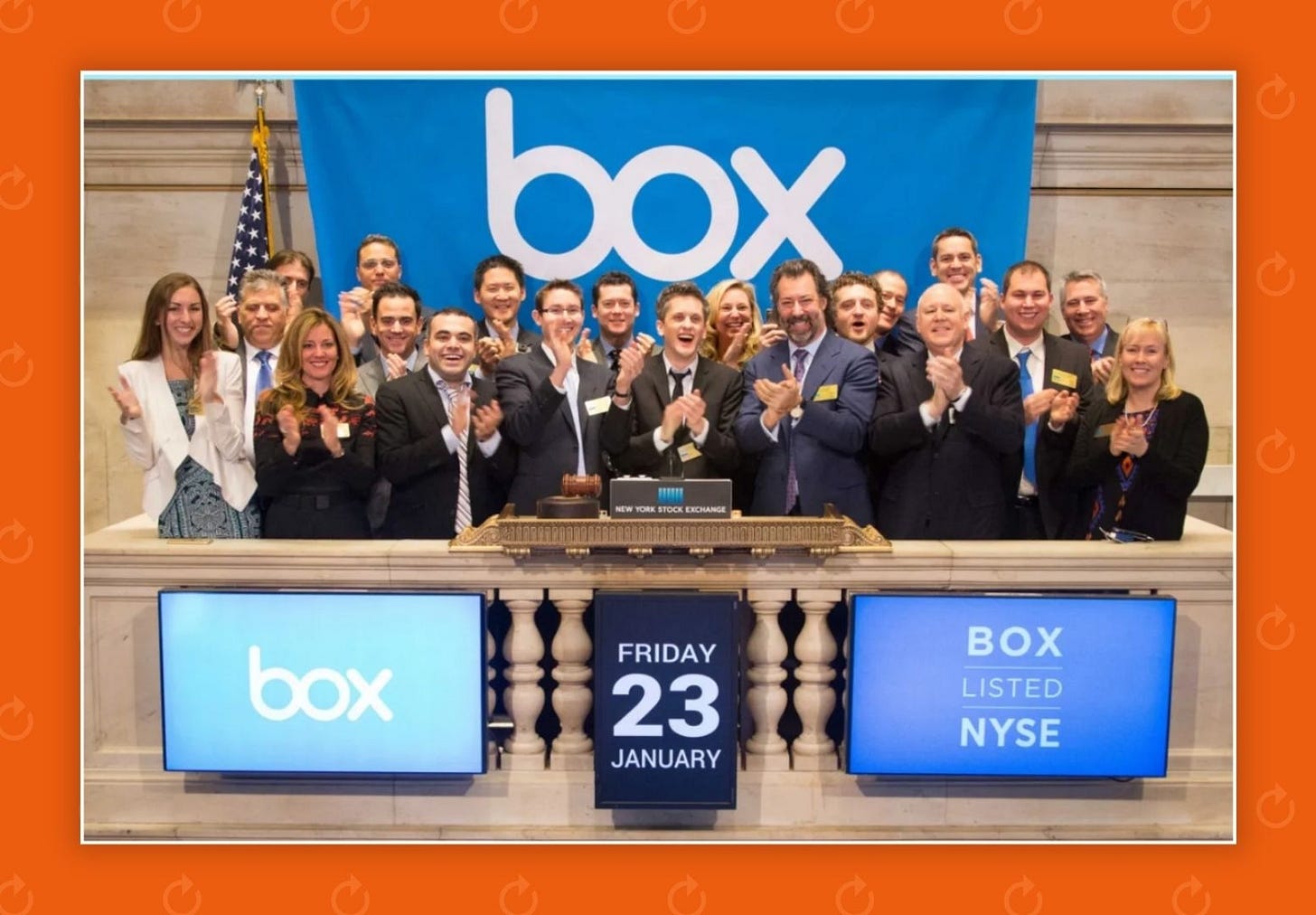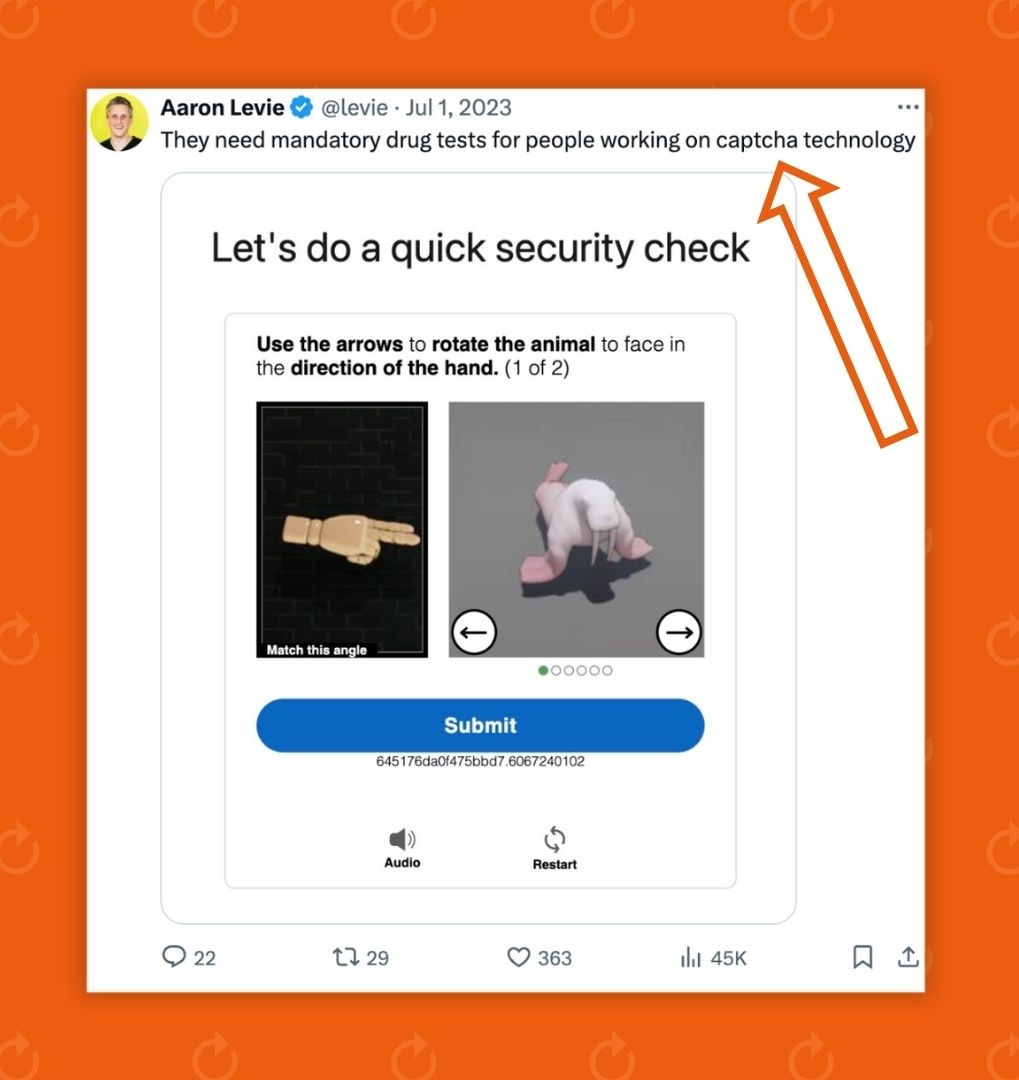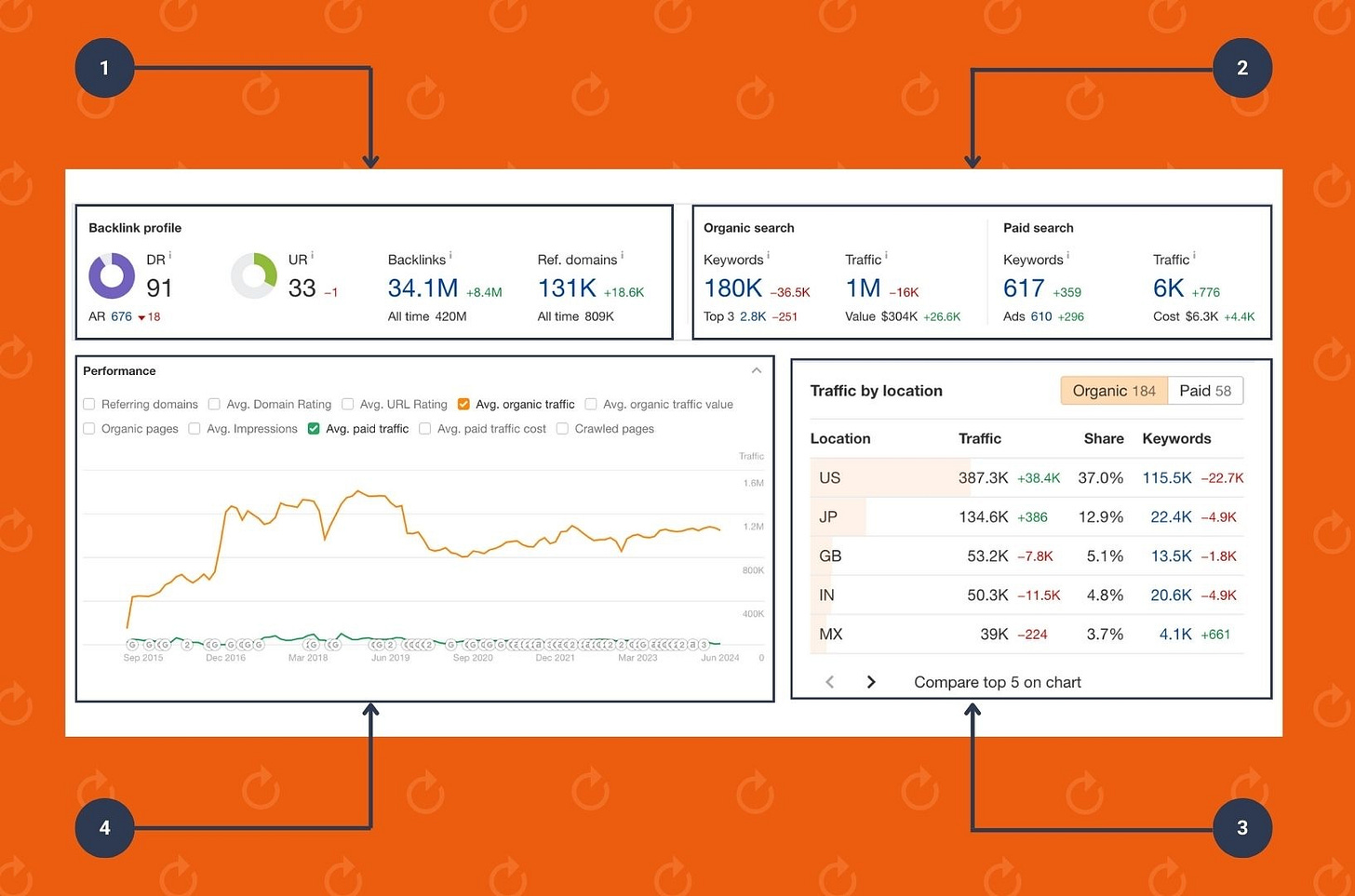Box's B2B Marketing Playbook
How a group of high school friends built a $3 billion startup through cold emails, GTM pivots, outdoor ads, and inventive B2B marketing strategies.
Aaron Levie was a student at the University of Southern California when he came up with the idea for Box. He was 20. His CFO, Dylan Smith, was 19.
Twenty years later, their company is worth $3.89 billion and serves nearly 100K customers, 69% of which are Fortune 500 companies. The journey from Aaron’s uncle's garage in Berkeley to 13 worldwide offices has been nothing short of a bumpy ride.
Let’s dive into the marketing tactics that earned Box the reputation of not-your-regular-startup.
In this playbook, we will review 3 Growth Principles, 2 CMOs, 12 Tactics, and Box’s Marketing Statistics, all illustrated with Examples and 🔍 Inside Scoops.
3 Growth Principles
Consumerizing Enterprise Software
While at USC with an undeclared major, Aaron found it cumbersome to share large files and collaborate on projects. To share files, people had to email them to themselves, juggle thumb drives, or wrestle with FTP. It was complicated and inefficient.
Recognizing these challenges and the rapidly decreasing storage costs, Aaron saw an opportunity. In 2005, he teamed up with his high-school friends - Dylan Smith, Jeff Queisser, and Sam Ghods - to launch Box.net.
For $2.99 a month, the web-based product allowed customers to upload files to Box and access them from anywhere. The idea took off, and Box quickly secured hundreds of sign-ups, securing the initial funding. To attract more investment and recognition, Aaron began sending cold emails to high-profile VCs.
Fortunately, one of these emails reached Mark Cuban’s inbox. Aaron asked the dot-com billionaire and Shark Tank personality to feature Box in his newsletter, Blog Maverick. Instead, Cuban sent a check for $350,000, giving Box the boost it needed to get started.
By 2007, giants like Apple, Google, and Facebook were entering the cloud storage arena. Box recognized the need to pivot quickly. In 2008, the company shifted its focus from consumer to enterprise businesses. Determined to create enterprise software that didn't suck, Aaron and his team started applying consumer-focused principles to their product.
"How do you take a sales force and a services organization that look more like a Salesforce.com or an Oracle or an IBM and marry that with a product and a cadence and a culture that moves like a Google or a Facebook? That’s what we’re trying to do at Box."
- Aaron Levie
Box transformed how companies viewed B2B products. It revamped design and usability, making adoption and implementation a breeze. The new strategy positioned Box as a leader in developing user-friendly enterprise software and set a new standard for how enterprise apps should look, feel, and function.
🔍 Inside Scoop
Not long after his investment, Mark Cuban wanted his money back. In 2006, taking inspiration from Flickr’s freemium model, Box went from being a pay-only service to offering 1 GB of free storage. To put things in context, Yahoo Briefcase offered the largest free storage at the time - just 25 MB.
This pivot didn’t sit well with Mark Cuban, who had invested based on the pay-only model. Upon learning of this strategy change, he wanted out. He told Aaron, “If you find other investors that want to go down this strategy, then I might not be one of those.”
Building Self-Service Experiences
In 2015, McDonald’s introduced kiosks and saw a 30% sales boost. Taco Bell found their app orders were 20% more profitable. Lumen saw a 112% sales jump with Amazon’s Just Walk Out tech. The secret? Creating self-service experiences and reducing social friction.
Box also jumped on the self-service bandwagon to consumerize enterprise software. When Chris Koehler became CMO, he tackled the issue of information accessibility. He realized customers were frustrated by the time they reached support, having already searched in vain.
People don't want to interrupt what they are doing. They just want to find answers, whether they talk to a human or some sort of chat pod technology. So, we spun up a huge project around self-service to see how we can leverage technology with humans as the overlay so they work in conjunction together.
- Chris Koehler
Chris believes that seamless experiences are as crucial as quality products. To optimize this, Box regularly conducts surveys for feedback. The team uses these insights to refine and create fresh content, continually sprucing up the Knowledge Center.
Emphasizing Repetition
In the TV show "Ted Lasso", Ted advises a player to "be a goldfish." He says a goldfish is the happiest animal on earth because of its ten-second memory. Turns out, Ted is wrong. A study by Microsoft found that the average human attention span went down from 12 seconds to 8 seconds, which is now shorter than that of a goldfish.
This creates a challenge for marketers. Companies roll out features, new capabilities, and product improvements at lightning speed. Marketers then go into a frenzy, announcing updates through websites, emails, newsletters, events, webinars, forums, and social media. But it's not enough.
The majority of our customers have so many things going on in their lives that they are not all of a sudden sitting down and saying “ Oh, let me go through and read exactly what Box just released and work through that”. It’s not how it happens.
- Chris Koehler
Box tackles this challenge with repetition and by activating its sales and customer success teams. Marketing doesn't just launch products; it educates customers through various touch points to boost adoption, cross-sell, upsell, and improve Net Retention Rate.
Box’s CMOs
Box hired its first CMO 11 years after its launch. Here’s a list of the CMOs at Box.
Carrie Palin, CMO of Box from July 2016 - July 2019
Carrie Palin served as the company’s first Chief Marketing Officer and held this position for 3 years.
She holds a Bachelor's degree in Communications from Texas Christian University.
Carrie's experience spans multiple companies, including IBM, Dell, SendGrid (acquired by Twilio), Splunk, and Cisco. She also serves as an advisor for Adobe Marketo and a board member for EDB and NetApp.
Chris Koehler, CMO of Box from July 2019 - May 2024
Chris Koehler was the VP of Customer Success at Box before being appointed as the company's CMO. He held this position for nearly five years.
Chris holds an undergrad from George Mason University and has an MBA in Marketing from Georgia State University, along with an executive education from Harvard.
Chris has worked at Claritas Corp, SunTrust Banks, E*TRADE, Visual Sciences, Adobe, and Twilio. He has also advised AnyLog, CareerVillage.org, Grishin Robotics, and Cresta.
Box’s Marketing Tactics
1. Enterprise Pricing Strategy
SaaS use cases are unique, and there's no one-size-fits-all solution. Product usage varies widely between regulated and unregulated industries. Compliance, scalability, tech stack, legacy systems, team structure, and security play a role in these differences. This makes standard pricing models tricky - unless you're Box.
Box shows its commitment to consumer-like flexibility in the enterprise market by offering standard plans and add-on services like Box Consulting, Migration Services, and Product Support. With transparent pricing and a freemium model, Box lowers the barrier to entry. In 2011, this strategy helped them close 60% of deals within two weeks.
2. Content Strategy
When it comes to content, Box keeps it simple. Their resource gallery features use cases, success stories, eBooks, and demos—all designed to quickly provide value to readers. Users can explore products with Box Chatbot, get support from Box Community Forums, and check service status on Box Status.
Staying true to its content guidelines, Box makes finding information 10x simpler. The vast repository of questions helps users get answers quickly, reducing effort for Sales and IT. This leaves Box to creatively use its $348.6 million sales and marketing budget on projects like The Box Beat, sponsored white papers, and feel-good customer stories.
3. Social Media
Box’s LinkedIn is all about promoting events and company culture. Dropbox may have more followers (454K as of June 2024), but Box wins in engagement, sometimes hitting 250 likes per post. Facebook, on the other hand, is the black sheep of the social media family.
Posts are frequent, but engagement is almost nonexistent, with many posts filled with unanswered inquiries, requests, and scams. On the brighter side, Instagram is better managed, featuring event snippets and #lifeatbox content. The feed is culturally vibrant and politically charged, reflecting the company’s Silicon Valley roots.
🔍 Inside Scoop
Box and Dropbox might sound like twins, but they're quite different. Both play in the cloud storage space, but Box focuses on enterprises, while Dropbox targets SMBs. Box wasn't born to battle Dropbox; it launched two years earlier and shifted its focus to enterprise customers by 2008.
In cloud content management, Box competes with heavyweights like Microsoft SharePoint and OpenText Documentum. In the enterprise file sync and share space, it competes with Microsoft OneDrive and Google Drive. Dropbox may be a secondary competitor, but its services, size, and tenure make it tempting to pit them against each other.
4. Advertising Strategy
Box has launched nearly 650 ads on LinkedIn, while Dropbox has rolled out 990. Given that 58% of marketers say LinkedIn provides the best return on ad spend, these numbers seem a bit low for both. The ads are straightforward, avoiding tech jargon and flashy colors. Formats include single-image ads, carousels, and videos, with language options in English, French, German, and Japanese (sorry, Spaniards).
Box leverages Google Ads to promote products and showcase competitive advantages. It has nearly 4000 ads on the platform in text and video formats. Interestingly, Box doesn't advertise on Facebook or Instagram. Fun fact: Box partners with AdRoll and Just Media to manage its campaigns.
🔍 Inside Scoop
One of Box’s earliest ads was a billboard targeting its giant competitor, Microsoft SharePoint. It may have been the new kid on the block, especially in the enterprise business, but that didn’t stop the company from making bold moves. The team pooled their salaries to buy a spot next to TechCrunch’s office, costing them $8K to $9K per month (a steal compared to today’s $46K).
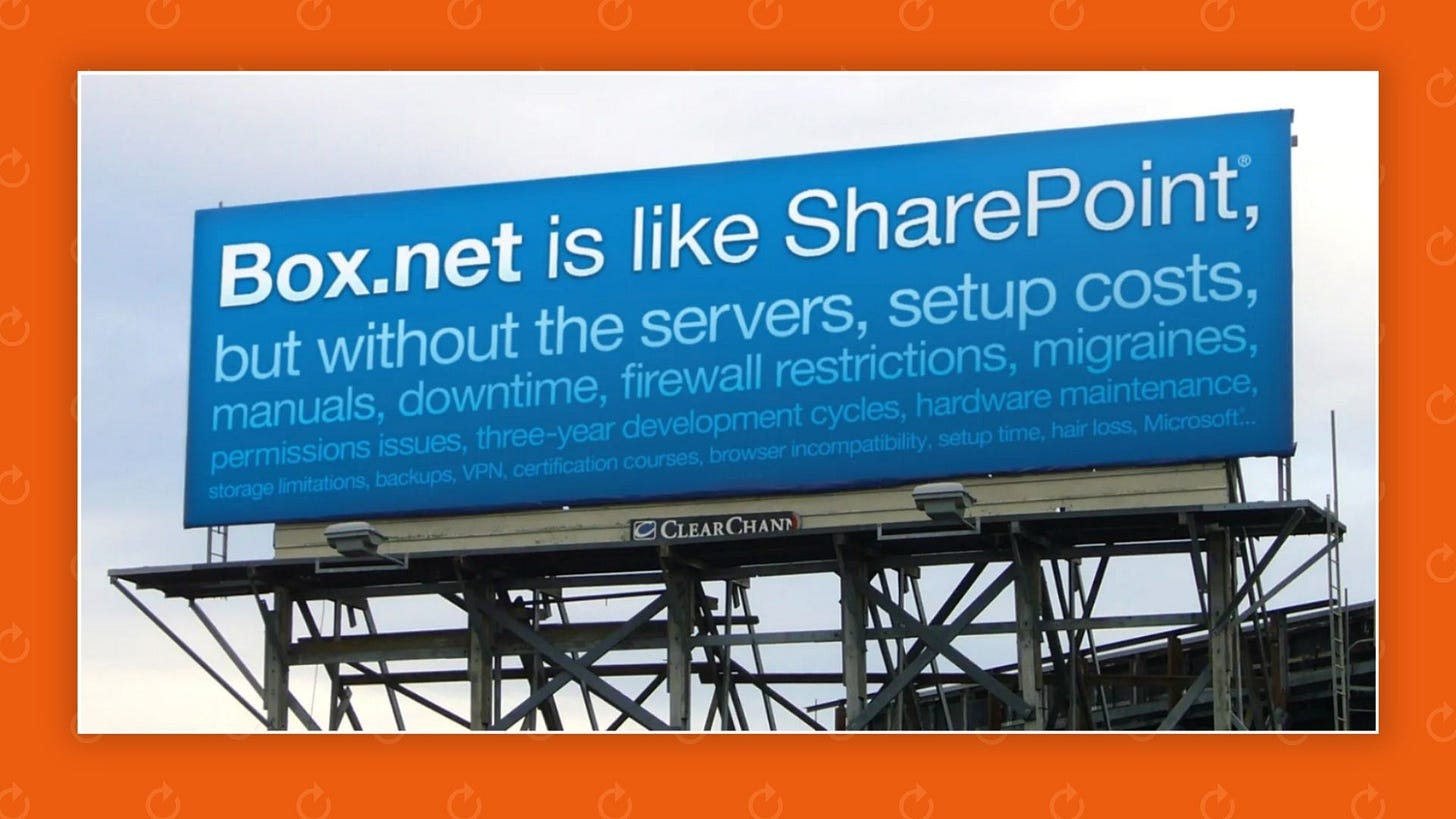
5. Thought Leadership Events
Box isn't just about the usual trade shows; it creates thought leadership events. During COVID, Box launched Work Unleashed, a series featuring interactive Q&As with the CEO and CIO. Speakers from Warner Brothers, Nationwide, IDEXX, Dubai Airports, and Broadcom shared best practices for navigating the new normal, making it Chris Koehler's favorite marketing campaign.
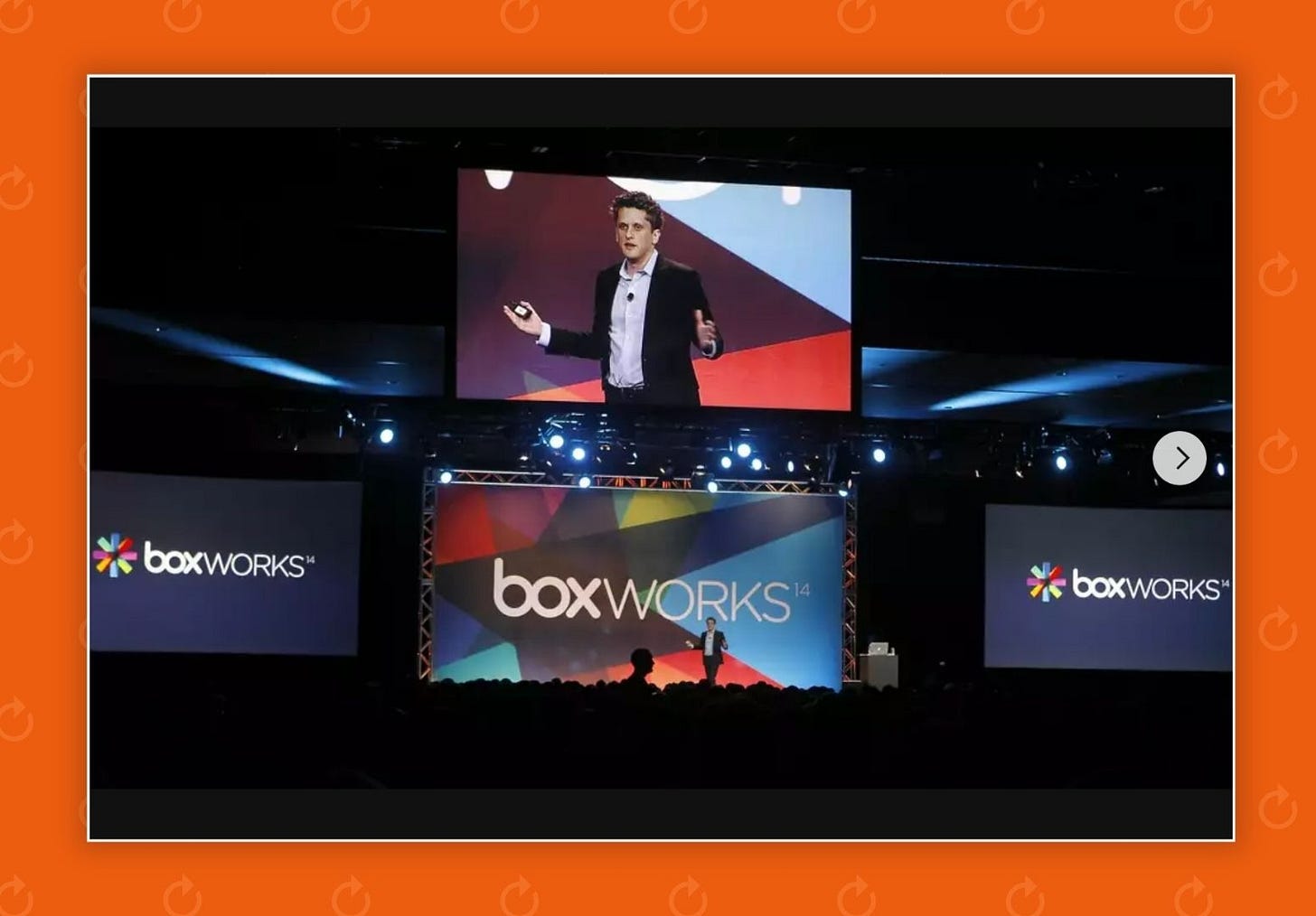
Another example is Box Next, a series designed to keep users updated on AI and machine learning advancements. And, of course, there's BoxWorks. This annual conference brings together experts, customers, partners, and prospects, featuring high-profile keynote speakers - and sometimes even Puppy Pits.
🔍 Inside Scoop
Chris Koehler believes that if he weren’t a marketer, he’d be a teacher. At Box, he’s managed to be both! In a classic thought leadership move, Chris organized an internal learning series, inviting fellow B2B CMOs to share their wisdom (oh, to be a fly on the wall). Beyond the usual marketing topics, the series delved into mentorship, networking, culture, and even imposter syndrome.
6. Partnerships With B2B Companies
If you can't beat them, join them. Box’s journey from competition to partnership goes beyond Microsoft. They integrate with Technology Partners like Google, Salesforce, IBM, Zoom, and ServiceNow to deliver the Content Cloud worldwide. New partners can easily submit integrations and get support through the community forum (classic self-service move).
Box also collaborates with Service Partners to move old content management systems to the cloud and build custom apps for various industries. Plus, Reseller Partners like CDW, Insight, SHI, and CarahSoft help spread Box’s services far and wide.
7. Promotional Offers
Box has run various limited-time promotions to attract new users. These include significant discounts on paid plans or extra storage for new sign-ups. In 2014, the company launched a "free storage for life" campaign, offering 50GB of free storage to iOS users. Another promotion doubled the space for free Personal accounts, grabbing attention, boosting sign-ups, and giving users bragging rights.
8. Developer Strategy
Unlike Twilio’s B2B Marketing Playbook, developers may not be at the heart of Box’s strategy. But Box hasn’t forgotten about them. With the BoxDev Platform, BoxDev Conference, Developer Community, BoxDev Newsletter, and Developer Blog, Box is all in on keeping developers happy and engaged. These initiatives show that Box is serious about giving developers the tools, resources, and support they need to create amazing integrations and innovations.
9. Press and Analyst Coverage
Box gets a lot of love from analysts, with positive coverage from Gartner, Forrester, and IDC. They spend up to $50K on each sponsored whitepaper or commissioned report with top industry analysts. As a public company, Box is often in the spotlight - sometimes for good reasons, sometimes not - which keeps its brand visible and boosts its reach.
🔍 Inside Scoop
In 2013, Box's London HQ was inaugurated by the Duke of York, Prince Andrew. Looking back, this might not be the kind of press coverage Box would want to highlight, given the subsequent controversies involving Jeffrey Epstein and the Prince.
10. Culture at Box
Another reason for Box's appeal? The "Boxers." Not the adorable four-legged creatures, but its employees often referred to by this name. Box takes pride in being diverse and inclusive, snagging multiple awards and often being named one of the best places to work.
Much of this positive energy comes from Box’s core team, including CEO Aaron Levie, who famously refuses to use an office and works collaboratively with his team. This culture fosters a strong sense of community and teamwork, significantly boosting Box's brand and marketing. Plus, the offices are pretty cool!

11. Aaron Levie as a Brand
A 20-year-old college dropout with messy hair, neon sneakers, and disruptive tech ideas, Aaron Levie is Silicon Valley’s dream. He is a full-time CEO and part-time juggler/ magician who turned ordinary file-sharing software into a leading collaboration platform. This transformation has made him one of the most-watched CEOs in recent years.
Aaron is extremely active on Twitter, doing more than just reposting Box content. His feed is a series of hilarious takes on tech, world politics, and mostly himself. His brand is an additive to Box’s online presence and contributes significantly to the overall perception of the company.
🔍 Inside Scoop
Before Box, Aaron had several ideas that didn't take off. There was Zizap, humorously dubbed by him as “the world’s fastest search engine if you have never been to Google,” and Fastest.com, a site for quickly sealing real estate deals.
Another failed attempt was Socalendar.com, a site listing events and parties in Southern California. Aaron attributes these failures to his lack of technical skills, admitting, "They weren’t very good websites." Despite these setbacks, his favorite acronym, WWSJD (What Would Steve Jobs Do), ultimately drove him to Box.
12. Brand Guidelines
Box's brand guidelines are their secret sauce for a polished, professional look. Their colors—Dark Blue (#003C84), Box Blue (#0061D5), and Box Gray (#151F26)—highlight their tech focus and optimistic vibe. The Lato font, with its semi-rounded sans-serif style, adds warmth and professionalism.
The Box Brand Style Guide is full of do’s and don’ts to keep the brand sharp and consistent across all platforms. Following these guidelines makes Box easy to recognize and trust, acting as a powerful marketing tool in the crowded tech world.
Marketing Statistics
Backlink Profile: Box has a high Domain Rating (DR) of 91, showing strong domain authority. They have 34.1 million backlinks from 131K referring domains. This means many websites link to Box, which is good for credibility, but the URL Rating (UR) of 33 suggests there's room to improve the quality of these links.
Search Engine Performance: Box ranks for 180K keywords, bringing in 1 million visits from organic search each month, valued at $304K. However, they've lost 36.5K keywords and 16K in traffic recently, indicating a need to improve their SEO strategy. On the paid search side, they target 617 keywords, generating 6K visits monthly for $6.3K, highlighting a potential area for cost efficiency.
Traffic by Location: The majority of Box's traffic comes from the US (387.3K visits), followed by Japan (134.6K), Great Britain (53.2K), India (50.3K), and Mexico (39K). The US market shows strong growth, but traffic from GB and India has declined, pointing to opportunities for better performance in these regions.
Trend Analysis: Box's traffic trends show fluctuations over time, with a decline in organic traffic from past peaks. This suggests they have strong strategies in place but need to address issues causing these drops. Paid traffic has seen a slight increase, indicating room for more stable growth.
Conclusion
Box’s marketing is truly out-of-the-box (pun intended). It uses consumer product principles for enterprise software, making the customer journey seamless. Box excels in thought leadership events, crisp advertising, and vibrant social media. Led by savvy leaders and a dynamic culture, Box blends consumer and enterprise strategies, making its marketing refreshingly human and engaging.
TL;DR CMO Brief
📝 Customer Case Studies: Box’s arsenal of customer case studies in the form of short blogs, long-form content and videos showcases real-world successes. This strategy has been instrumental in landing approximately 100K customers, including 67% of the Fortune 500.
🛒 Self-Service Experiences: Box applies consumer product principles to enterprise software, creating a seamless self-service journey on its website. From the moment users enter, they can easily find all the information they need, enhancing user satisfaction and engagement.
🧠 Thought Leadership Events: Box is a leader in tech conversations through its annual Box Works conference and on-demand webinars like Box Next and Work Unleashed. These events are cleverly used to integrate company updates, product announcements, and new features, reinforcing its market presence.
🔗 B2B Integrations: Box’s strategic integrations with major B2B enterprise products have transformed potential competitors like Microsoft, Google, and IBM into partners. The pivot from the consumer market to enterprise SaaS has strengthened Box’s market position and resilience.
⭐ Aaron Levie: CEO Aaron Levie’s dynamic presence - characterized by his witty tweets and interactions with other tech leaders - adds significant value to Box’s reputation. His brand keeps the industry and customers engaged with Box’s latest developments.





